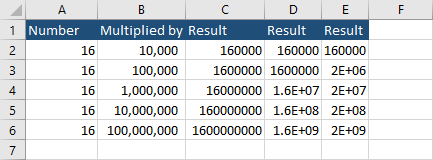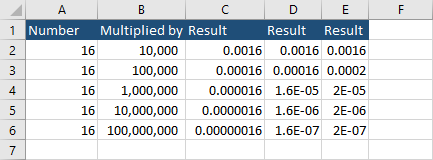While working with Excel, you may have noticed that sometimes the letter E appears in the calculation. In some cases, after the letter E there was a positive number, and sometimes a negative one.
This is called scientific notation. Excel uses this notation to display a result in a shorter form, otherwise, it would have to display only part of a number as it does with text.
What does scientific notation do?
When Excel displays a number in scientific (exponential) notation, it means that it takes part of a number before E and multiplies it by 10 to the power of a number after E.
Here’s a simple example to illustrate it.
123,456,789 = 1.23 * 10^8
The number will stay the same, but it will show it in a shortened, less precise form. So when you write the formula = 1.23 * 10^8 it will display it as 123,000,000.
But you can also find less precise notations:
=1.2 * 10^8 (120,000,000)
=1*10^8 (100,000,000)
It all depends on the amount of space you have inside your cell.
Let’s take a look at a practical example in Excel.

Example explanation
In column A you have numbers that are multiplied by numbers in column B. In columns: C, D, and E you have the same result. The only difference is the different amount of space in cells.
Column C – all results fit inside this column.
Column D – the 2 first results (D2 and D3) fit inside cells. The other 3 use scientific notation.
Column E – Only the first result fits inside a cell, the other results use the scientific notation. What’s also interesting, to save space Excel uses even less precise notation – 1.6 is rounded to 2.
You can also use scientific notation for fractions.

This time instead of plus (+) after E, you have the minus sign (-).
